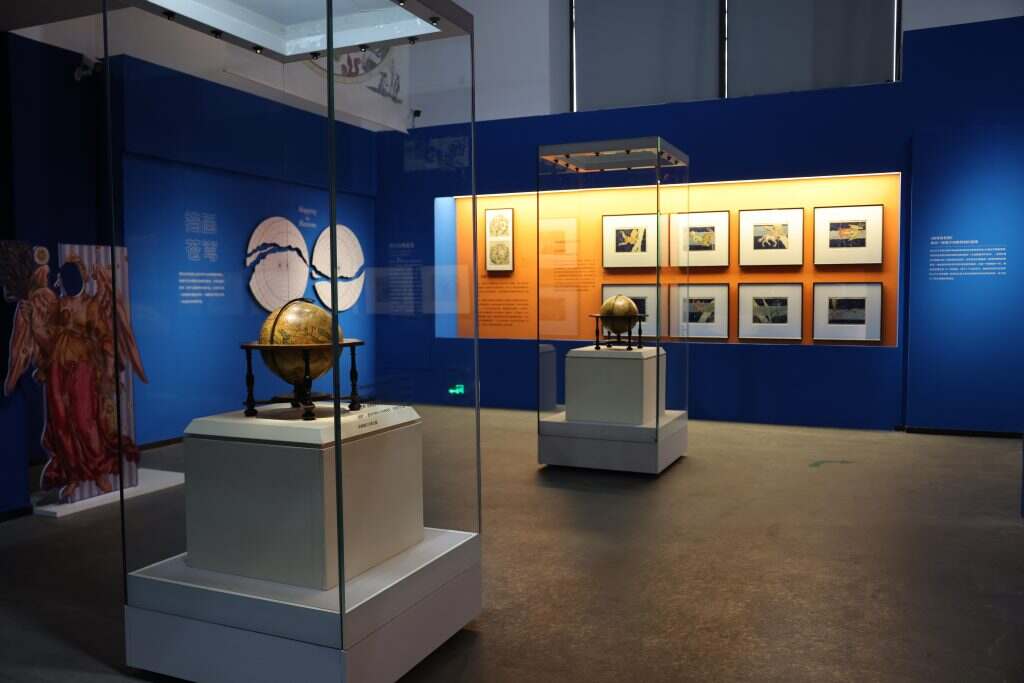
On July 18th, the "Exploring the Constellations and a Treasury of Ancient Celestial Atlases" exhibition will grandly open at the Zhejiang Museum of Natural History(Anji). Jointly organized by Zhejiang Museum of Natural History and Ptolemy Museum (Hong Kong), the exhibition will feature over 80 Eastern and Western astronomical artifacts from the Ptolemy Museum's collection, alongside 7 meteorite specimens from Zhejiang Museum of Natural History. Together they will present humanity's historical and future perspectives on mapping the heavens, offering visitors China's largest-ever exhibition of celestial cultural relics.
The exhibition is structured along the trajectory of civilizational progress, presenting the history of humanity's contemplation of the stars through four thematic chapters:
Chapter 1: "Imagining the HeavensFirmament"
Surveys how ancient civilizations across the East and West envisioned the cosmos, weaving myth, belief, and early astronomical observation into their understanding of the night sky.
Chapter 2: "Mapping the Heavens"
Showcases splendid star charts from classical Chinese and Western traditions, illustrating the integration of scientific inquiry, philosophical thought, and aesthetic expression in celestial mapping.
Chapter 3: "Touching the Firmament"
Offers an immersive encounter with meteorites—fragments of asteroids or other celestial bodies—allowing visitors to engage directly with material born in space.
Chapter 4: "Exploring the Firmament"
Traces the evolving journey of astronomical exploration, from early instruments like the astrolabe to the development of various telescopes, highlighting how each technological advance expanded our vision and deepened our intellectual engagement with the universe.

China's Largest Celestial-Themed Cultural Relics Exhibition: A Scientific and Artistic Spectacle of the Stars
This exhibition draws upon the Ptolemy Museum's specialized collection of astronomy-themed cultural relics, combined with specimens from the Zhejiang Museum of Natural History, to present over 80 rare artifacts and natural specimens. Most are original pieces, making this the foremost exhibition of its kind in China. The diverse range of exhibits includes ancient printed books, manuscripts, engravings, rubbings, bronze mirrors, astronomical instruments, and meteorites, all weaving together the multifaceted history of how various civilizations across the world have understood the starry sky.
A Celestial Tapestry Through the Lens of Civilizational Exchange
Spanning four historical periods—prehistoric, classical, medieval, and modern—the exhibition showcases the history of celestial exploration across multiple Eastern and Western civilizations. It highlights the positive role of cultural exchange in promoting scientific progress throughout history. For instance, the Song Dynasty's "Astronomical Chart" is displayed alongside related Japanese and Korean artifacts, using specific examples to illustrate the broader theme of Chinese civilization's inclusiveness and cultural confidence. This guides visitors to appreciate the Eastern hues in our vast universe, while also revealing the two-way exchange of astronomical knowledge between China and the West through detailed examination of artifacts like the "Huangdao Zongxing Tu" (General Star Map of the Ecliptic).
The Four Great Western Classical Star Atlases Debut Collectively in China for the First Time
The "Uranometria," "Firmamentum Sobiescianum," "Atlas Coelestis," and "Uranographia," created from the 17th to the 19th century, are renowned as the "Four Great Classical Star Atlases." Celebrated for their scholarly innovation and artistic excellence, they heralded a golden age for European celestial cartography. This marks the first time these four seminal atlases are being exhibited together in China. The 26 displayed works are mostly exquisite copperplate prints hand-colored after printing, allowing visitors to trace the evolution of star mapping over centuries while appreciating the lines and colors of classical European art.

A Deep Integration: Ancient Star Charts with Meteorites and Celestial Themes
From historical star maps and constellations to meteor showers and meteorites, the exhibition makes the cosmos tangible through the display of physical meteorite specimens. Zhejiang Museum of Natural History is presenting several meteorites from its collection for the first time, including the Zhejiang Tanxi Witnessed Meteorite and rare Lunar Meteorites. Under the theme “Touching the Firmament,” the narrative traces the stories of constellations, fireballs, and meteorites across Eastern and Western astronomical traditions, inviting visitors to experience the enduring fascination of astronomy.
Highlight Artifacts: Incunabula, Early Telescopes, and Harmonia Macrocosmica
Beyond celestial cartography, the exhibition presents a range of exceptional artifacts that visitors won’t want to miss:
Incunabulum “Astronomica”: The earliest surviving printed work systematically documenting all 42 constellations and the zodiac, reflecting the fusion of early astronomy and poetry.
Harmonia Macrocosmica: A masterpiece from the 17th-century golden age of Dutch cartography, acclaimed as the most magnificent celestial atlas in history. Six original hand-colored copperplate prints from this work will be displayed.
Historical Instruments: The exhibition also features antique astrolabes, refracting and reflecting telescopes from 18th–19th century Europe, and navigational instruments—offering telescope enthusiasts a rare domestic opportunity to appreciate these treasures.
“Exploring the Constellations and a Treasury of Ancient Celestial Atlases” is more than a retrospective of humanity’s celestial explorations across Eastern and Western civilizations—it is a cultural feast integrating science, art, and education. While admiring the beauty of scientific achievement and artistic expression, visitors are invited to reflect on the brilliance and depth of human civilization, reinforcing our collective ambition to explore the universe and embrace the future.
The exhibition will run for three months, divided into two phases: The first phase will display the Uranometria, Hevelius Star Atlas, and Flamsteed Star Atlas. The second phase will replace these with the "Uranometria," "Firmamentum Sobiescianum," "Atlas Coelestis," and "Uranographia". Throughout the exhibition, the organizers will host expert lectures and public education activities, offering visitors diverse and enriching perspectives on the cosmos.